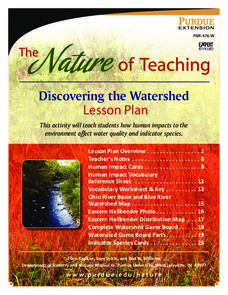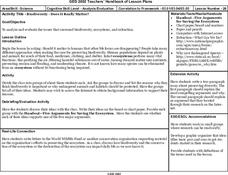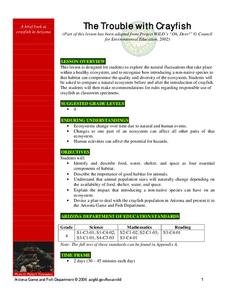US Mint
Desert Dwellers
What can a quarter possibly teach young learners about desert ecosystems? More than you might think. After displaying and discussing the included picture of the Arizona state quarter, the class participates in a series of...
Berkshire Museum
Camouflage!: Collecting Data and Concealing Color
Help young scholars see the important role camouflage plays in the survival of animals with a fun science lesson. Starting with an outdoor activity, children take on the role of hungry birds as they search for worms represented by...
American Museum of Natural History
Life in the City
Believe it or not, biodiversity exists even in areas of disturbed habitat. An interactive activity challenges learners to look for species with a magnifying lens in an image of a city habitat. Pop-up images and descriptions explain how...
Curated OER
Animal and Plant Cell Journaling Activity
Jump into the classification of animal and plants cells, through this inviting lesson comparing Elodea leaves and Epithelial cells. Middle school learners will create wet mounts, write journal entries that compare specimens, and finally...
Sea World
Saving the Wild: Conservation Around the World
Enhance your unit on conservation, ecosystems, or migration with a series of lessons about ways to save the wild around the world. Kids research types of conservation, such as recycling, and use their geography skills to map the...
Purdue University
Discovering the Watershed
Human impact on watersheds can make or break an ecosystem. Learners use a game to learn about the impact human choices have on water quality and the organisms that depend on it. The activity includes a game board and game cards that tell...
Florida International University
Are You Concentrating?
Explore the importance of a concentration gradient in the rates of dissolution. Using the ocean ecosystem, learners study rates of dissolution around coral reefs. A hands-on experiment helps individuals discover the effects of changing a...
EngageNY
Close Reading: Blue Creek, a Rainforest in Belize (Page 12)
Peace and quiet. After reading page 12 of The Most Beautiful Roof in the World, scholars participate in a silent conversation with a chalk talk activity. They take turns describing how the rainforest is diverse by writing on chart...
Curated OER
Water Filtration
As an example of nature's water filtering system, young ecologists conduct an experiment in the lab. They construct a funnel out of a plastic bottle, fill it with specified layers of materials that simulate layers of soil, then run muddy...
It's About Time
Who Eats Whom?
Packed with visual aids and multiple learning opportunities, an engaging exercise challenges individuals as they explore the role of producers, consumers, and decomposers. After discussing differences between food chains, food...
Curated OER
Predators Among Us
Students study environmental science. In this ecosystems lesson, students discover how humans have an impact on life in the coral reef. They watch video clips and work on small group activities. This lesson includes links to the videos...
Curated OER
Biodiversity - Does It Really Matter?
Students examine biodiversity, ecosystems, and extinction. They are divided into groups to discuss why they think biodiversity is important.
Curated OER
Seahawk Educational & Environmental Discovery Program
Pupils identify and describe local poisonous plant/animals. They compare characteristics of three local ecosystems and describe common plants from different ecosystems; comparing shapes, colors, textures, and measuring sizes.
Curated OER
Biomes -- Part 1
Students use the internet to locate and gather information on the world's biomes. They compare and contrast biomes to ecosystems and describe the human effects on ecosystems. They answer questions to end the activity.
Curated OER
The Rainforest Community
Students create a miniature rainforest ecosystem, a terrarium. Students then explain how the continuous flow of energy and food in the ecosystem allows it to sustain itself.
Curated OER
Wild Thing!
Sixth graders view several segments of the video, "How Animals Survive." They discuss elements of survival. Students list living and nonliving things found in their backyards and schoolyards. Students work in groups to complete the...
Curated OER
Biodiversity
Students complete activities to study the importance of biodiversity. In this biodiversity lesson, students find images to categorize into organism groups and illustrate their interconnections. Students use measurement tools to study a...
Curated OER
Habitat Mural
Young scholars build a collage of an ecosystem. The goal is for them to understand interactions in a community, plant and animal adaptations, and how all life depends on plants. This activity is based on Wump World and students describe...
Curated OER
Oh Where, Oh Where, Can My Industry Be?
Young scholars conduct observational studies of three ecosystems by visiting the Web World Wonders website. They gather data, compare/contrast the information, and decide on the establishment of a nuclear power plant at one site over the...
Curated OER
Which One Matters?
Learners study the balance necessary to maintain ecosystems and how changing that balance can impact the ecosystem. They identify and discuss the need for balance in any ecosystem and discuss how greenhouse gases impact ecosystems.
Curated OER
Web of Life
Students collect information about various organisms in a forest ecosystem and create a mural that depicts organism interdependence. They then simulate a food web using a ball of string.
Curated OER
Spring of Life
Students explore Florida's springs using video segments. In this video lesson plan, students examine Florida's springs ecosystem, the animals that live there and the red tide that threatens the environment. The lesson plan includes...
Curated OER
The Trouble with Crayfish
Fourth graders compare an ecosystem before and after they introduce crayfish to that ecosystem. In this ecosystem lesson plan, 4th graders see what happens when you introduce a non native animal to a habitat. Students then make...
Curated OER
Bugs in the Woods
Second graders identify insects and plants in the forest ecosystem in a structured field trip with stations and activity booklets. In this bugs lesson, 2nd graders explore the ecosystem of the forest, complete the booklet and play...























